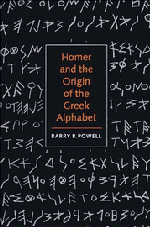Book contents
- Frontmatter
- Contents
- List of figures
- List of tables
- Acknowledgements
- Abbreviations
- A note on terms and phonetic transcriptions
- Chronological charts
- Maps
- Foreword: Why was the Greek alphabet invented?
- 1 Review of criticism: What we know about the origin Greek alphabet
- 2 Argument from the history of writing: How writing worked before the Greek alphabet
- 3 Argument from the material remains: Greek inscriptions from the beginning to c. 650 b.c.
- 4 Argument from coincidence: Dating Greece's earliest poet
- 5 Conclusions from probability: how the Iliad and Odyssey were written down
- APPENDIX I Gelb's theory of the syllabic nature of West Semitic writing
- APPENDIX II Homeric references in poets of the seventh century
- Definitions
- Bibliography
- Index
5 - Conclusions from probability: how the Iliad and Odyssey were written down
Published online by Cambridge University Press: 01 June 2011
- Frontmatter
- Contents
- List of figures
- List of tables
- Acknowledgements
- Abbreviations
- A note on terms and phonetic transcriptions
- Chronological charts
- Maps
- Foreword: Why was the Greek alphabet invented?
- 1 Review of criticism: What we know about the origin Greek alphabet
- 2 Argument from the history of writing: How writing worked before the Greek alphabet
- 3 Argument from the material remains: Greek inscriptions from the beginning to c. 650 b.c.
- 4 Argument from coincidence: Dating Greece's earliest poet
- 5 Conclusions from probability: how the Iliad and Odyssey were written down
- APPENDIX I Gelb's theory of the syllabic nature of West Semitic writing
- APPENDIX II Homeric references in poets of the seventh century
- Definitions
- Bibliography
- Index
Summary
“What was he, what was his trade, what did he do?”…
“Nothing, he had no trade, nothing but his horse and his arms and he went about the world. He was blind in one eye and his clothes and arms were of the finest. And he went thus from town to town and sang to everybody to the gusle.”
The real riddle is who wrote down the poems and why.
(A. B. Lord)Homer's floruit falls within the first half of the eighth century. He is perhaps an exact contemporary of the adapter. At the very least, he lived within fifty years of the invention of an idiosyncratic writing that cocks the ear to fine distinctions of sound and is used in its earliest remains to record hexametric verse. If the alphabet was fashioned to record the poet Homer and no other, we can account for the coincidence in time. If we believe that the adapter restructured Phoenician writing not in order to record Homer specifically, but in order to record “hexametric verse in general,” meaning a poet or poets of whose existence and achievement all memory has been lost, we must admit that at the same time, or within a generation and a half at most, the new writing was also used to write down Homer.
- Type
- Chapter
- Information
- Homer and the Origin of the Greek Alphabet , pp. 221 - 237Publisher: Cambridge University PressPrint publication year: 1991



